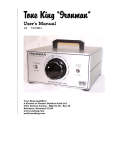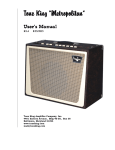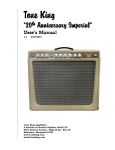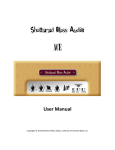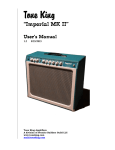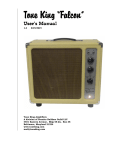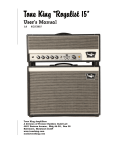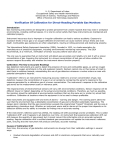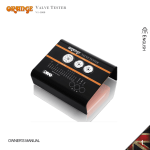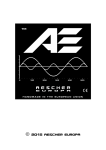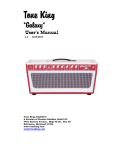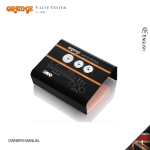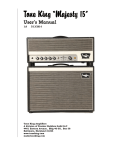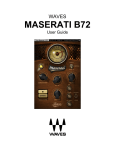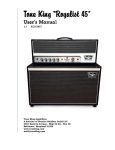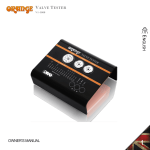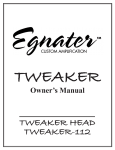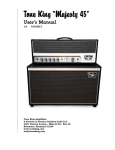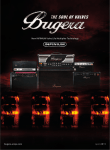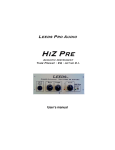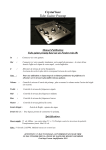Download - Tone King
Transcript
Tone King “Imperial” Vacuum-Tube Guitar Amplifier User’s Manual R1.0 12/6/2007 Tone King Amplifier Company, Inc. 4401 Eastern Avenue, Bldg 45-2A, Box 38 Baltimore, Maryland 21224 Thank You Thank you for purchasing this Tone King Imperial amplifier. Please read this user’s manual in its' entirety before operating the amp. If you have any questions or concerns not addressed here, please feel free to contact designer/builder Mark Bartel at [email protected]. Contents 1. Basic Operation Power Source Power On, Power Off, Standby Channel Switching 3 3 3 3 2. Rhythm Channel Sample Setting 4 4 3. Lead Channel Tone Control Mid-Bite Control Sample Settings 5 5 5 6 4. 6 Using Effects Pedals 5. Reverb 7 6. Tremolo 7 7. Tube Functions 8 8. Tube Choices 9 10 9. Block Diagram 2 1. Basic Operation Power Source Important ! Your Imperial amplifier MUST be plugged into a properly grounded outlet. Do not attempt to defeat or “lift” the ground of the AC supply. Power On, Power Off, Standby Mode When powering up the amp, you should start off with both the POWER and STANDBY switches in the "off" position. First, turn on the power switch. This will apply power only to the tube filaments. After turning on the power switch, wait about a minute, and then turn on the STANDBY switch. The amp will then be ready for use. When turning off the amp, turn off both the POWER and STANDBY switches. The order that you turn them off is not important. When the amp is operating, turning off the STANDBY switch will put the amp in standby mode. In this mode, the tubes will remain heated, but the power supply to all amplifier circuits will be cut off, which disables the amp. You might find this mode useful if you only want to shut the amp off for a brief period of time, and you don't want to wait for the tubes to heat up again, as you would if you powered down the amp. Channel Switching You can switch between the Imperial's two preamp channels (Rhythm and Lead) by using either the channel switch on the front panel or the channel switch on the footswitch. When using the footswitch, however, you must leave the front panel Channel switch in the Rhythm position in order for the footswitch to operate properly. 3 2. Rhythm Channel The Rhythm channel is voiced a lot like a classic blackface Princeton or Deluxe, and is best for clean tones and slightly overdriven tones of this variety. Its' voicing isn't really appropriate for heavily distorted tones. Sample Setting Here's a good sample setting to get started with this channel: Volume 3 Treble Bass 4 7 4 3. Lead Channel The Lead channel is not a distortion channel or even an overdrive channel. The lead channel preamp itself cannot be driven into overdrive or distortion. Its' purpose is to shape the tone of the signal driving the output stage so that the output stage is driven into overdrive or distortion in a particular manner. This fact must be understood in order to successfully use the lead channel. You may find that the clean (undistorted) sound of this channel is a bit lacking in bass, or a bit midrange-heavy at some settings of the mid-bite control. This is an intentional design feature, as the tone will thicken, the bass will fill out, and the overall tonal spectrum will even out as the volume control is turned up to allow the output tubes to saturate and compress. Tone Control The Lead channel's Tone control is a simple treble roll-off type control, similar to that used on early "tweed" amps. Mid-Bite Control The Mid-Bite control is not simply a midrange control. It affects several aspects of the tone. When set all the way off (counterclockwise), this channel is voiced much like a "tweed" amp - a "boxy" sort of sound with a lot of lower midrange and a smooth top end. This is a good setting to use for “boxy” jazz tones with humbucker equipped guitars (with the volume set fairly low). It's also great for honky-tonk country/blues tones with a telecaster. As you turn up the Mid-Bite control, you'll find that it tightens up the bass and brings out more of the mid-to-upper midrange, which causes the output stage to distort in a more "English"-sounding manner. All the way up, you'll notice a sudden increase in gain between settings 9 and 10. This allows you to push the amp into a thicker distortion tone without losing control of the bottom end, or without excessive compression. 5 Sample Settings Here are a few sample settings to get started with the Lead channel: Description Volume Tone Mid-Bite Tweed Clean 2 4 0 70's Rock Distortion 4 6 5 Saturated Distortion 4 7 10 4. Using Effects Pedals When using overdrive or distortion pedals, I suggest selecting the Lead channel, and setting the controls for the “Tweed Clean” sound shown in the table above. Overdrive and distortion pedals can tend to have a harshness which is nicely rounded off by the Lead channel with this setting. Overdrive and distortion pedals can sound harsh and buzzy when used with the Rhythm channel, because this channel is voiced with more clarity and detail in the top end, which exaggerates any buzziness created by these type of effects. 6 4. Reverb The Imperial uses a tube-driven full-size 2-spring reverb pan, to create an authentic 1960's reverb sound. Reverb is applied to both the Rhythm and Lead channels. The single Reverb control on the front panel determines the amount of the reverb signal which is mixed with the dry signal for both the Rhythm and Lead channels. 5. Tremolo The Imperial's tremolo circuit uses a very early method of amplitude modulation. This method applies the tremolo oscillator signal directly to the grids of the output tubes, which varies the bias of the output tubes in response to the oscillating tremolo signal. In doing this, the gain of the output tubes is modulated, creating a tremolo effect. This type of tremolo circuit was used on very early guitar amplifiers by Fender, Gibson, and several other companies. More "modern" tremolo circuits use an opto-coupler to attenuate the signal under control of the tremolo oscillator signal, and create a tremolo effect. This type of circuit can be found in many of the "blackface" Fender amps. I have chosen to avoid the opto-coupler approach, and instead implement the grid bias modulation method, because it creates a rounder, softer, tremolo effect. Controlling the Tremolo When the footswitch is plugged in, you can turn the tremolo effect on or off with the footswitch. When the footswitch is not plugged into the amplifier, the tremolo circuit is always active, so you must turn the tremolo depth down all the way if you don't want a tremolo effect. 7 9. Tube Functions V1 1st gain stage (lead+rhythm), 2nd gain stage (lead) Sovtek 12AX7WA V2 2 gain stage (rhythm), 3rd gain stage (lead) Sovtek 12AX7WA V3 Reverb Driver 12AT7 V4 Reverb Receiver Sovtek 12AX7WA V5 Phase Inverter Sovtek 12AX7WA V6, V7 Output Tubes 6V6EH V8 Rectifier Sovtek 5AR4 nd Alternate Tube Selections The Imperial is delivered with the tube types shown in the chart above. These tube types are used because they are the same types which have been used in the Imperial since it was first built in 1993. However, this tube complement can sometimes develop too much gain and sound a bit thin with some guitars. If you wish to decrease the gain (for more headroom), and fatten up the sound, I suggest trying these alternate tube types: V1 1st gain stage (lead+rhythm), 2nd gain stage (lead) 12AU7 (EH or NOS) V2 2 gain stage (rhythm), 3rd gain stage (lead) Sovtek 12AX7LPS V5 Phase Inverter Sovtek 12AX7LPS nd Replacing Output Tubes The output tubes are cathode biased in the Imperial, so there is no bias adjustment. This type of biasing scheme self-adjusts to a fairly wide range of tube characteristics. Because of this, replacing the output tubes involves nothing more than pulling out the old tubes and plugging in the new ones. 8 10. Tube Choices At this point in time, I believe that genuine vintage tones can only be obtained by the use of vacuum tubes. Although tubes sound great, there are very valid reasons why they were abandoned by the electronics industry over 40 years ago. Tubes are fragile, generate a lot of heat, are sensitive to mechanical vibration, and subject to manufacturing defects. I have selected the particular tube types used in the Imperial because of their particular tonal qualities. I feel that they provide the most well-balanced tone which works well with all guitars and all settings. Many customers find that they wish to tailor the tone of their amp to their particular tastes by using different brands of tubes. If you are considering using NOS output tubes, I suggest using the old RCA 6V6GT (not the later types 6V6GTA, 6V6GTB, or 6V6GTY). This tube has a fabulously smooth and organic sound quality. Currently available tubes are not of the same quality level as in the 1950's. Recently manufactured tubes are built in China, Russia, or the Czech Republic, and are not built to the same quality standards that, say, RCA used to manufacture tubes in the U.S., in the 1950s. It would seem that the obvious solution would be to use new-old-stock tubes from these older periods. However, I've found that some of these new-old-stock tubes have gone gassy or developed other problems. As a result, we musicians must recognize that, while we prefer to use vacuum tubes because of their tone, they can be imperfect devices, and are most certainly the least reliable component in the entire amplifier. Tube problems generally reveal themselves as a crackling noise which can occur continuously, sporadically, in response to mechanical vibration, or in response to your playing (e.g. a crackling or other type of noise which occurs only when you hit a note). I subject all tubes to a thorough burn-in and test procedure to ensure that they are fully up to spec and operating perfectly. However, you must be aware that the majority of tube failures occur early in their life, and may come about as a result of the jostling and jarring that an amp can receive in shipping. In spite of the exhaustive testing I perform at the shop, early-life tube problems cannot always be found in such testing. The first two months or so are the most tenuous period for any set of tubes. Most manufacturing defects will be revealed in the first two months of their life, but many are not detectable in initial testing, even after a burn-in period. If you notice any noises, cracking, or any other odd behavior of your amplifier in this period, note that it is most likely to be the result of a defective tube, and should be debugged as such. 9 9. Block Diagram 1 Premier Builders Guild LLC Limited Warranty Premier Builders Guild – Tone King Amplifiers Division 201 S. Highland Avenue, Box 204 Pittsburgh, PA 15206 This warranty gives you specific legal rights; you may also have other rights which vary from state to state. There are no express warranties except those listed below. Length of Warranty This warranty shall remain in effect for five years from the date of sale of the product as shown on the original bill of sale. What is Covered This warranty covers all defects in material and workmanship in this product, with the following exceptions: 1. Damage or deterioration of the cabinet, or any other cosmetic damage which occurs after delivery is not covered by this warranty. 2. Damage after initial delivery resulting from accident, unreasonable use, or neglect, is not covered by this warranty. 3. Damage resulting from the performance of repairs by someone other than the Tone King Amplifier Company is not covered by this warranty. 4. Damage occurring during shipment or delivery of this product to the Tone King Amplifier Company after initial delivery of the product is not covered by this warranty. 5. Vacuum tubes are considered a user-replaceable item, as they are expected to wear out and require replacement over a reasonable period of time. Tubes are warranted to be serviceable for a period of 90 days from the date of sale. 6. The speaker(s) in this amplifier has(have) been selected for use only with this amplifier. If the speaker(s) of this amplifier is(are) connected to an amplifier other than the intended amplifier, any warranty of this speaker shall be deemed void. What We Will Pay For The Tone King Amplifier Company will pay for all labor and material expenses to fix or replace all items covered under this warranty. The customer will pay shipping charges to return the product to the Tone King Amplifier Company. If the necessary repairs are covered under this warranty, the Tone King Amplifier Company will pay any shipping charges required to return the product to the customer. Limitation of Implied Warranties All express or implied warranties of merchantability and fitness for a particular purpose are limited in duration to the length of this warranty, unless otherwise provided by state law. Exclusion of Certain Damages The Tone King Amplifier Company’s liability is limited to the repair or replacement, at our option, of any defective product, and shall in no event include incidental or consequential damages of any kind. Some states do not allow limitations on the length of an implied warranty and/or do not allow the exclusion of incidental or consequential damages, so the above limitations and exclusions may not apply to you. Obtaining Warranty Service If your unit requires service, it should be returned to the Tone King Amplifier Company at the address listed above. Before returning the unit, you must contact the Tone King Amplifier Company and obtain return authorization. 12












